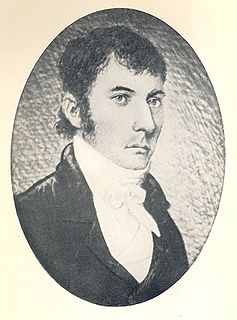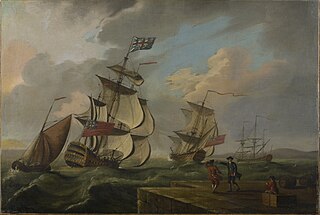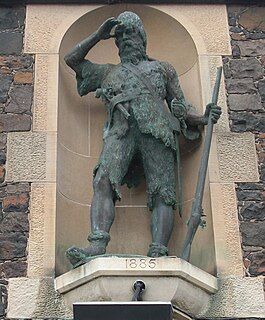 W
WBrigadier General Benedict Arnold was an American-born senior officer of the British Army who commanded the American Legion in the later part of the Revolutionary War. He is best known for his defection from the Continental Army to the British side of the conflict in 1780. General George Washington had given him his fullest trust and placed him in command of the West Point, New York. Arnold planned to surrender the fort to British forces, but the plot was discovered in September 1780 and he fled to the British lines. Arnold's name quickly became a byword in the United States for treason and betrayal because he led the British army in battle against the very men whom he had once commanded.
 W
WJonathan Barnet was an English privateer active in the Caribbean. He is best known for capturing pirates Calico Jack, Anne Bonney, and Mary Read.
 W
WJoseph Barss was a sea captain of the schooner Liverpool Packet and was one of the most successful privateers on the North American Atlantic coast during the War of 1812.
 W
WGeorge Charles Beckley was an English captain, trader, and military adviser. He was one of the earliest foreigners to have a major impact in the Kingdom of Hawaii, where he would eventually become a noble, and was one of the disputed creators of the Flag of Hawaii.
 W
WEdward Teach, better known as Blackbeard, was an English pirate who operated around the West Indies and the eastern coast of Britain's North American colonies. Little is known about his early life, but he may have been a sailor on privateer ships during Queen Anne's War before he settled on the Bahamian island of New Providence, a base for Captain Benjamin Hornigold, whose crew Teach joined around 1716. Hornigold placed him in command of a sloop that he had captured, and the two engaged in numerous acts of piracy. Their numbers were boosted by the addition to their fleet of two more ships, one of which was commanded by Stede Bonnet; but Hornigold retired from piracy toward the end of 1717, taking two vessels with him.
 W
WHezekiah Frith, Sr. (1763–1848) was an 18th-century British ship owner with the reputation of a "gentleman privateer", who engaged in piracy during the 1790s. One of the richest men in Bermuda during the late 18th and early 19th centuries, he built the Spithead House in Warwick, Bermuda.
 W
WCaptain Gincks was a privateer based in New York. He is best known for sailing alongside Adrian Claver, and for a violent incident involving his sailors while ashore.
 W
WJohn Halsey was a British privateer and a later pirate who was active in the Atlantic and Indian Oceans during the early 18th century. Although much of his life and career is unknown, he is recorded in A General History of the Pyrates which states "He was brave in his Person, courteous to all his Prisoners, lived beloved, and died regretted by his own People. His Grave was made in a garden of watermelons, and fenced in with Palisades to prevent his being rooted up by wild Hogs."
 W
WWilliam Hutchinson was an English mariner, privateer, author, and inventor who developed parabolic reflectors for lighthouses and helped establish possibly the world's first lifeboat station.
 W
WThomas Johnstone (1772–1839) was an English sailor, smuggler and Admiralty saboteur. He was commonly known as Johnstone the Smuggler or the Hampshire Smuggler. Writing in 1823, biographer John Brown described Johnstone as a real-life Rob Roy.
 W
WJohn Martel was a French pirate active in the Caribbean.
 W
WAlexander McDougall was a Scottish-American seaman, merchant, a Sons of Liberty leader from New York City before and during the American Revolution, and a military leader during the Revolutionary War. He served as a major general in the Continental Army, and as a delegate to the Continental Congress. After the war, he was the president of the first bank in the state of New York and served a term in the New York State Senate.
 W
WWilliam Field Porter was a ship owner from Liverpool, who migrated to South Australia in 1838. He relocated to Auckland in 1841, where he became a member of the New Zealand Parliament.
 W
WWoodes Rogers was an English sea captain and privateer and, later, the first Royal Governor of the Bahamas. He is known as the captain of the vessel that rescued marooned Alexander Selkirk, whose plight is generally believed to have inspired Daniel Defoe's Robinson Crusoe.
 W
WJohn Rous was a privateer and then an officer of the Royal Navy. He served during King George's War and the French and Indian War. Rous was also the senior naval officer on the Nova Scotia station during Father Le Loutre's War (1749–1755). Rous' daughter Mary married Richard Bulkeley (governor) and is buried in the Old Burying Ground.
 W
WAlexander Selkirk was a Scottish privateer and Royal Navy officer who spent four years and four months as a castaway (1704–1709) after being marooned by his captain on an uninhabited island in the South Pacific Ocean. He survived that ordeal, but succumbed to tropical illness years later while serving aboard HMS Weymouth off West Africa.
 W
WGeorge Walker was an English privateer active against French shipping.